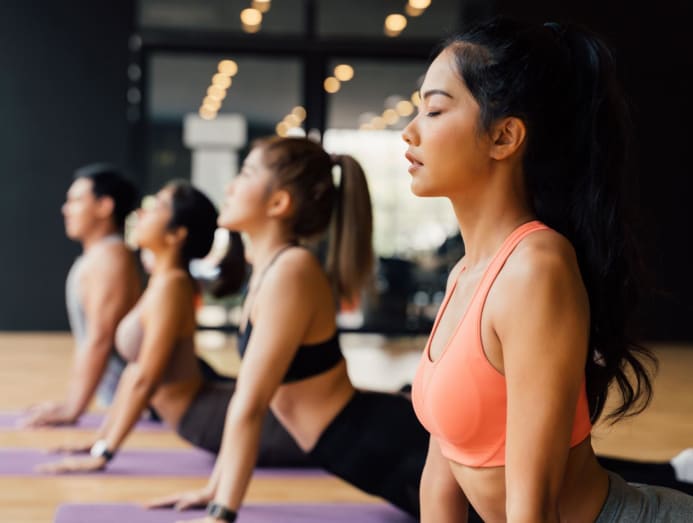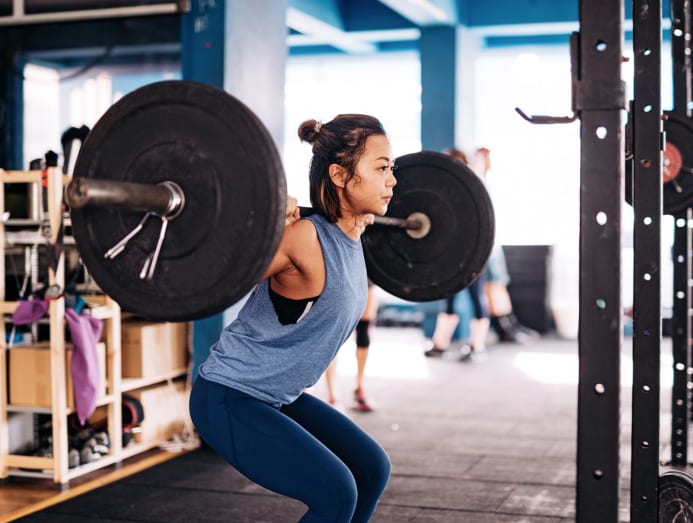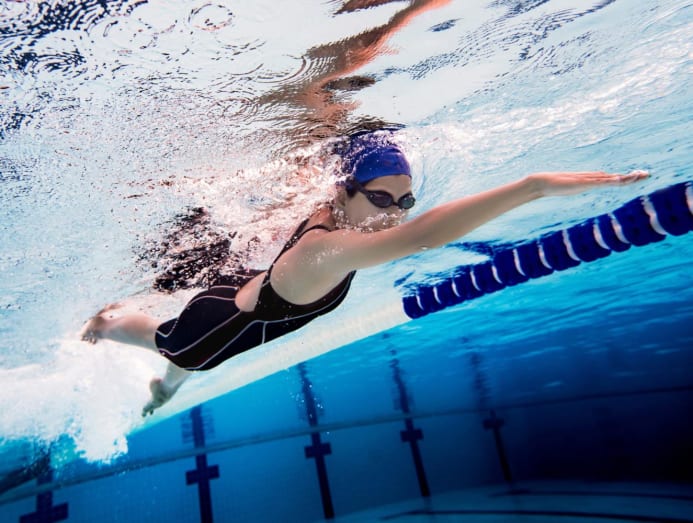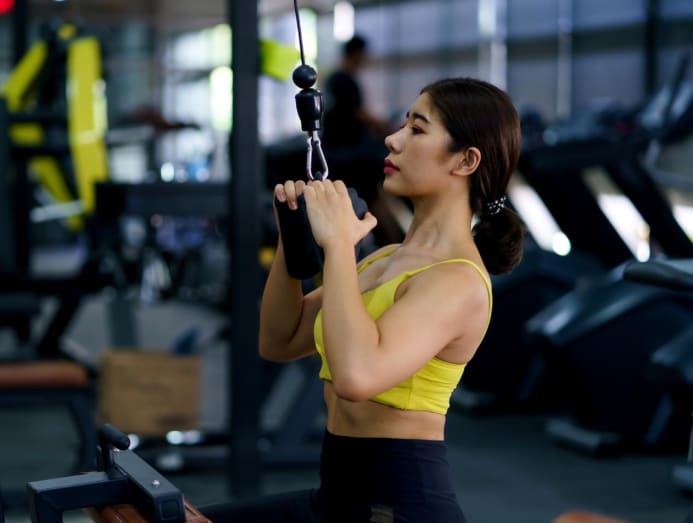Women and periods: How to adjust your exercise routine to your menstrual cycle to make the most out of it
Understanding your menstrual cycle is normal but syncing your lifestyle habits to it? From exercise to diet and even types of activity to help you live closely to your body’s bio-rhythm, cycle syncing may help optimise your energy for exercise.

Syncing exercise to your menstrual cycle may be effective for maintaining a healthy routine in the long run, said a fitness trainer. (Photo: iStock/Peera_Sathawirawong)
Ever planned for an activity weeks in advance but when it came down to it, you were fatigued, moody and unable to carry on? And it wasn’t even your period yet! According to some experts, it is likely to be hormonal and it may be helpful to do cycle syncing.
Cycle syncing is the practice of adjusting your lifestyle according to your menstrual cycle. This includes matching your diet, exercise and even lifestyle activities according to your cycle.
The concept was first introduced in a 2014 book by US-based functional nutritionist Alisa Vitti, also the founder of Floliving.com and creator of the MyFlo app.
Diagnosed with Polycystic Ovarian Syndrome (PCOS), a condition which affects hormone levels, causing the body to skip menstrual periods, Vitti spent more than 10 years creating The Cycle Syncing Method to help women tune into their menstrual cycle. Her method tracks, evaluates and then prescribes eating and exercise routines to help women optimise their hormones throughout the cycle.
Cycle syncing may benefit women who have PCOS, feel fatigued often, face varying energy levels that affect their moods and who are trying to conceive.
The idea of adapting lifestyle to hormonal shifts allows women to increase their performance at work and in recreation, while enjoying better overall function, weight management, fewer skincare issues and happier lives.
KNOWING YOUR CYCLE AND WHAT TO DO AND EAT
Essentially, you’ll need to understand how your menstrual cycle works. Each woman’s cycle can vary from 21 to 35 days but 28 is the average. These four weeks are broken into these phases: Menstrual, Follicular, Ovulatory and Luteal.
In her book Womancode, Vitti writes that understanding your body’s reactions during these phases allows you to optimise activities to play up to those strengths. Here’s how:
DAY 1 TO 5: MENSTRUAL PHASE
This phase starts when the uterus sheds its lining and bleeding occurs. Because you’re losing blood and iron, most women feel fatigued and experience symptoms like abdominal cramping and discomforts like insomnia, headaches and nausea.

Hormones: Oestrogen and progesterone decline. Oestrogen, which is secreted by the ovaries, regulates growth and development while progesterone’s primary function prepares the uterus for pregnancy.
Exercise: Because of the blood loss, the woman’s body may not feel up to a lot. If your body says no, listen and slow down to rest.
Avoid: High intensity interval training (HIIT) or high-volume exercises requiring lots of energy.
Try: Gentle forms of yoga, stretching and long walks.
Nutrition: Eat iron-rich foods like red meat, liver, poultry, bone broths, soups or stews and include dark leafy greens like spinach and kale. Some Traditional Chinese Medicine (TCM) advice include taking “warming” foods like turmeric, garlic, cinnamon and ginger.
DAY 6 TO 12: FOLLICULAR PHASE
Your period is over and your ovaries are growing many follicles that contain eggs. One egg will eventually take over. Menstrual symptoms such as cramping disappear and women find they have better energy levels as their mood improves.
Hormones: Oestrogen, progesterone and even testosterone levels start to rise. Oestrogen also causes the uterine lining to thicken.

Exercise: As hormone levels rise, your body builds muscle effectively in this phase. A study by Dr Lisbeth Wikström-Frisen in 2016 at Sweden’s Umea University found that training in this stage is good for muscular strength, power and muscle mass.
Try: Resistance (weights) and circuit training.
Nutrition: To fuel your energy for growing follicles, increase your protein intake with quality animal cuts (beef and poultry) or plant-based protein. Also important are healthy fats from fatty fish like salmon, tuna and sardines or avocados, nuts and seeds.
DAY 12 TO 17: OVULATORY PHASE
From Day 12, the body releases an egg into the fallopian tubes. If the egg is fertilised during this phase, you fall pregnant.
Hormones: Oestrogen and luteinising hormones peak. Progesterone also rises. The higher levels of testosterone also mean that one exudes confidence. If you’re not planning on babies, do take precautions when having sexual activity.

Exercise: This is the right time to seek personal bests and embark on high-energy, speed activities. Athletes may find that they will perform well on time trials.
Try: Adding strength or resistance training in your regime like F45 or intense HIIT.
Don’t forget to warm up, this study found higher oestrogen levels may make one injury-prone.
Nutrition: Because you’re at your peak, eat foods that support metabolism. Get your minerals and vitamins from cruciferous vegetables like broccoli, cauliflower and brussels sprouts. Fruits packed with antioxidants like berries also support liver function.
DAY 18 TO 28: LUTEAL PHASE
This phase can last from 10 to 12 days. Most women find their energy levels dipping and feel moody or easily agitated. With lower energy, they feel tired often. Other symptoms include bloating, or skincare issues like acne.
Hormones: Hormone levels decrease if pregnancy has not occurred. The body gets ready for a new menstrual phase.

Exercise: Dial down exercise intensity during this phase as your energy levels out. In warmer climes like Singapore, experts say take the workouts indoors to avoid dehydration as the body’s basal temperature is higher during this time.
Try: Lower impact exercises like strength training minus the intense cardio, or Pilates and yoga.
Nutrition: The body’s metabolic rate increases causing you to feel hungry. Those Pre-Menstrual Syndrome (PMS) cravings are real. To help with the ‘hangry’ feelings, eat foods that increase serotonin (the happy hormone), like dark chocolate. Also consider foods with complex carbohydrates and magnesium like sweet potatoes, whole grains and seeds.
CYCLE SYNCING AND EXERCISE
A personal trainer specialising in women’s functional training, Ashley Tay of Ashley Tay Fitness, is a believer of cycle syncing. “Some of my clients experience fatigue, insomnia and bloating – all classic PMS symptoms. My training programme will then focus on appropriate strength training, with less focus on cardio or core exercises so as not to aggravate the symptoms.”
Tay herself practises cycle syncing and lifts more weights in her follicular phase and then practises yoga every day in her luteal phase.
“Syncing exercise to a woman’s cycle is effective for maintaining a healthy routine in the long run and drives positive effects on the woman’s psycho-biological well-being.
“The appropriate amount of exercise stimulates endorphins (our body’s natural painkillers) and dopamine that promote positive thoughts and improve moods, making exercise enjoyable and sustainable,” Tay said.

Anna Tong, an accredited exercise scientist, a certified strength and conditioning specialist, and the co-founder of LOAD, believes women should “periodise” their training based on their cycles. Similar to cycle syncing, periodisation is planning and designing a training programme to improve performance and prevent injury.
“Even among highly active women, energy fluctuations during PMS can occur, affecting training motivation. Powering through is possible but exercise technique and form can be compromised. You may increase the risk of injury or burnout from overtraining,” she added.
However, there aren’t enough medical studies on cycle syncing and research has been anecdotal. Dr Lim Min Yu of Astra Women’s & Fertility Specialists, said: “While it is plausible that changes in exercise performance are observed because of the differing hormonal profiles in the different phases of the menstrual cycle, to date, the evidence on this has been conflicting.”
He cites a 2020 study which studied the effects of the menstrual cycle on a woman’s exercise performance, and the results were inconclusive. Dr Lim said: “The recommendation is that an individual approach is better than general guidelines on exercise performance during the woman’s menstrual cycle.”

Head coach of online training at TSquared Lab, Raghav Katyal, has coached clients who operate business-as-usual throughout their cycle while others have struggled to get out of bed, due to low energy and other symptoms. His programme, like Tay’s, then adjusts accordingly. “Different women will react differently. What’s practical is to consider specific individuals and adapt accordingly.”
He agreed though that the science needs more research as some studies have suggested that higher strength levels correlate to better strength gains in the follicular phase.
UNDERSTANDING YOUR BODY IS KEY
Other coaches interviewed felt that tailoring the exercise regime would help ride the varying energy levels. But the key is to know your body.
Evan Button, founder of Buttongenic, said: “I prefer not to overthink it. I listen to my clients because who wants to train if they are low on energy, mood and ‘crampy’?
“Some women are more susceptible to discomfort than others. But if it’s always low, then we relook at her overall routine and find what’s taking away her energy. Perhaps consider a blood test.”
Any dip in performance is minor, Button added, and barring any health conditions, the discomfort is temporary. “Unless you’re an Olympic athlete, where performance counts, consistency is key. Make time for a good, undistracted walk to promote circulation around the body. Otherwise, find an exercise which you like to do, then stick with that.”

Dr Lim Bao Ying, a registrar with the Department of Sport & Exercise Medicine, Changi General Hospital (CGH), added: “The hormonal flux in oestrogen and progesterone levels across the cycle exerts biochemical changes on the woman’s metabolism, blood volume levels and thermo-regulation (body temperature) thus causing some differences in physical performance.”
She added that these energy dips affect both active and sedentary women. However, fit women who have a robust exercise regime in place may have acclimatised to their bodily performance during their menstrual cycle.
BE CONSISTENT TO POWER THROUGH YOUR CYCLE
There is no clear win-or-lose with cycle syncing but consistency is the biggest factor to ride the waves of your menstrual cycle.
An easy way is to use basic menstrual trackers via an app or a wearable device like Fitbit, says Dr Lim of CGH: “Stick to your routine as much as you can.”
Astra’s Dr Lim has a simple recipe for women to stay active in their cycle: Get adequate rest and sleep, eat healthily and drink plenty of water to stay hydrated with at least 1.5 to two litres a day.
“Each woman is different but the more fit and active one is, the more likely one is able to keep to their routines throughout their cycles,” he said.
CNA Women is a section on CNA Lifestyle that seeks to inform, empower and inspire the modern woman. If you have women-related news, issues and ideas to share with us, email CNAWomen [at] mediacorp.com.sg.







